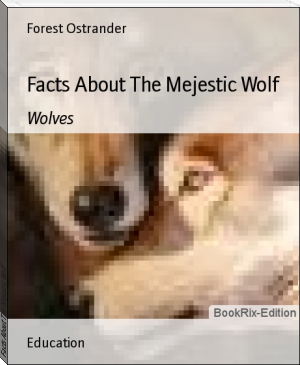Facts About The Mejestic Wolf by Forest Ostrander (autobiographies to read txt) 📖

- Author: Forest Ostrander
Book online «Facts About The Mejestic Wolf by Forest Ostrander (autobiographies to read txt) 📖». Author Forest Ostrander
Wolf Facts
The wolf is the largest member of the canine family. Grey wolves range in color from grizzled grey or black to all-white. As the ancestors (or cousins) of the domestic dog, the grey wolf resembles German Shepherds or Malamutes.
Wolves are making a comeback in the Great Lakes, northern Rockies and Southwestern United States.
Fast Facts
Height: 26-32 inches (7-8m) at the shoulder
Length: 4.5-6.5 feet (1.4-2m) from nose tip to tip of tail
Weight: 55-130 Ibs (25-59kg); Males are typically heavier then the females
Lifespan: 7-8 years in the wild, but some have lived 10 years or more
Diet
Wolves eat ungulates, or larged hoofed mammals, like elk, deer, moose and caribou. Wolves are also known to beaver, rabbits, and other small prey. Wolves are also scavengers and often eat animals that have died due to other causes like starvation and disease.
Population
There are an estimated 7,000 to 11,200 wolves in Alaska and more than 5,000 in the lower 48 states. Around the world there are an estimated 200,000 in 57 countries, compared to up to 2 million in earlier times.
Range
Wolves were once common throughout all of North America but were killed in most areas of the United States by the mid 1930s. Today their range has been reduced to Canada and the following portions of the United States: Alaska, Idaho, Michigan, Minnesota, Montana, Wisconsin and Wyoming.
Mexican wolves are found in New Mexico and Arizona.
Thanks to the reintroduction of the wolves in 1995, Yellowstone National Park is one of the most favored places to see and hear wolves in their native habitat.
Behavior
Wolves live, travel and hunt in packs of 4-7 animals on average. Packs include the mother and father wolves, called the alphas, their pups and several other subordinate or young animals. The alpha female and male are the pack leaders that track and hunt prey, choose den sites and established the packs territory. Wolves develop close relationships and strong social bonds. They often demostrate deep effection for their family and may even sacrafice themselves to protect the family unit.
Wolves have a complex communication system ranging from barks and whines to growls and howls. While they don't howl at the moon, they do howl more when it's lighter at night, which occures more often when the moon is full.
Reproduction
Mating season: January or February
Gestation: 63 days
Litter Size: 4-7 pups
Pups are born blind and defensless. The pack cares for the pups until they mature at about 10 months of age.
Threats
The most common cause of death for wolves is conflict with people over livestock losses. While wolf predation on livestock is fairly uncommon, wolves that do prey on them are often killed to protect the livestock. Defenders are working with livestock owners to develop non-lethle methods to reduce the chances of a wolf attacking livestock. These methods include fencing livestock, lighting, alarm systems and removing dead or dying livestock that may attract crnivores like wolves.
Another seriouse threat is human encrochment into wolf territory, which leads to habitat loss for wolves and their prey species.
Overall, the greatest threat to wolves is people's fear and misunderstanding about the species. Many fairy tales and myths tend to misrepresent wolves as villainous, dangerous creatures.
Reasons For Hope
Defenders and many other conservation organizations have been working tirelessly on wolf conservation in North America from aerial hunting in Alaska to restoration efforts in the lower 48 states. Wolves are an integral part of an ecosystem as a top tier preator and Defenders will continue to make sure the iconic symbol of America always has a place here.
Legal Status/Protection
Endangered Species Act (ESA): Wolves throughout the lower 48 United States are listed as endangered except in Minnesota where they are listed as threatend. In Alaska, wolves are not listed under the ESA.
In Wyoming and portions of the Southwest wolves are designated as non-essential experimental populations, which isolates geographically-described groups from other existing populations and offers broader managment regulations.
Did You Know?
Wolves can range in color, from pure white in Artic populations, to brown, grey, cinnamon, and black.
Historic Victory for Northern Rockies Wolves!
On August 5, 2010, a federal judge overturned a decision by the U.S. Fish and Wildlife Service (FWS) to remove grey wolves from the Endangered Species Acy (ESA), restoring their endangered status and paving the way for these critical predators to rebuild their numbers to ecologically sustainable levels. This ruling is the result a lawsuit brought against the FWS in 2009 by Defenders of Wildlife and other conservation organizations.
"Pups are born completely blind and deaf (but have a keen sense of smell), depending on their mother and other members of the pack. The whole pack takes care and raises the pups (non-breeding females produce milk and males compete to baby sit),"
Usually four to six pups are born together. This is called a litter, and the pups in a litter are called litter mates. Pups are born inside a den. A den is sometimes a small cave or a hole dug out of the ground.
The den must be big enough for the mother and her pups. It shelters them from the weather and protects the pups from other animals that may want to hurt them. Packs sometimes use the same den year after year. At other times, they make or find a new den each year.
Wolf pups at this age may be preyed upon by Golden Eagles, Bears can also prey on young pups. There are several records of a number of adult wolves decoying bears away from their pups' den until they left.
Gestation Period
Pups grow inside their mother for about 63 days before being born. At birth they weigh only one pound, and their eyes are closed. Pups grow quickly. About 12 to 15 days after they are born, they open their eyes. By two weeks of age, the pups can walk, and about a week after that, they may come out of the den for the first time. At first, they live only in milk from their mother.
The Birth and Nursing
After birth the female wolf will lick the fetal sac from the puppy's head (she will also swallow all of these membranes), this allows the pup to take its first breath. The plecenta attached to the pup by the umbilical cord will be delivered along with the pup. The mother severs the cord and eats the plecenta (eating the plecenta provides a valuble meal when she is unable to hunt).
The female wolf will lick the puppy dry and encourages it to nurse. The pup will instinctivly mobve to the warm underbelly and nuzzles around to find a teat. The mothers mammary glands secrete colostrum, a watery milk which contains important antibodies. During nursing the mother will clean the pups and stimulates them to urinate and defecate by licking the genital region. She swallows all of their excretions, keeping the birthing area clean abd oder-free.
Stages of Development
10-13 days: The eyes open
3 weeks: The milk teeth appear, they start to explor the den
4-5 weeks: Short trips outside the den, begin to eat meat
6 weeks: Moving up to a mile from the den (with adult wolf)
6-8 weeks: Pups are weaned, traveling to rendezvous site.
12 weeks: Begin to travel with the pack on hunts (with adult wolves)
15-28 weeks: Milk teeth are replaced
7-8 months: Begin to hunt with the pack
Mortality
Pup mortality ranges from 30% to 60%. Pups die from diseases, malnutrition, and starvation , life in the wild can be difficult. Wolves being very social animals are known to burry dead pups, In R.D Lawrences' "In Praise of Wolves" pack members "mourn as deeply as might a human family".
In Early Years
In a few weeks (4-5 weeks), the pups start eating meat. This is brought to them in the stomachs of the adult wolves. The pups lick around the mouth of the adult, the food cames back up into the adult's mouth. This sounds terrible to us, but wolf pups love it!
All the wolves in a pack help take care of the pups. When the pups are very small, other pack members bring
 The desire to acquire knowledge about the surrounding world and human society is quite natural and understandable for a person. Life is so developed that an uneducated person will never occupy a high position in any field. Humanity in its mass, and each person individually, develops objectively, regardless of certain life circumstances and obstacles, but with different intensity. The speed of development depends on the quality of training.
The desire to acquire knowledge about the surrounding world and human society is quite natural and understandable for a person. Life is so developed that an uneducated person will never occupy a high position in any field. Humanity in its mass, and each person individually, develops objectively, regardless of certain life circumstances and obstacles, but with different intensity. The speed of development depends on the quality of training.




Comments (0)